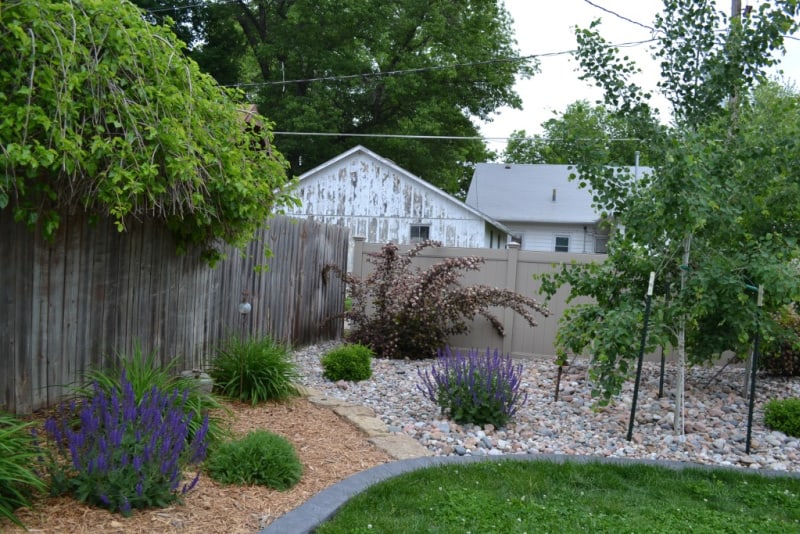Recently, I became much more aware of the various types of borders in my gardens. Why you ask? Because of the curse of the lawn mower. Since late summer 2021, I have had an endless string of bad luck with mowers. First, our long running rider broke down and refused to go. The repair man said it was not fixable. Our second rider barely moves and we only used it to haul, not mow. Now it is broke. Also, we have gone through 3 push mowers, though push mowing an acre of grass on a hill is no fun.
Anyways, the more mowing issues I have had, the more I look at expanding the garden beds, and the more I look at borders. I do not mean edging by itself, but using plants along the edges, in borders. But what plants are best for borders? And can they be used in place of inorganic edging such as stone, brick, or steel?
Hardscape Edging
When I look back at the thousands of landscapes I have managed, designed, or helped to install, I can only think of a handful which did not use some sort of hard edging material along the borders. Why are Americans so determined to use materials other than plants to hold back the landscape? Is it because grass is so aggressive that it practically needs a flame thrower to subdue it? Or are we just always trying to keep in the rock or mulch used around our plants?
The latter is probably the more likely supposition. Why? Because at most of the landscapes I visit, homeowners mow their own lawns, and they rarely edge the beds, not caring about the grass slowly creeping over the border. But it is a problem for me, because at least once a year I have to go in and dig out the turf that has crept over the steel or stone edging. They do not pay me to trim or edge the beds (at least most do not).

Even I my own home I use various kinds of edging materials on most of my beds. In the front yard I use fieldstones, mostly because they are free around here, and because I like the look of them. But I also have brick borders around my Sunny Cottage Garden. However, these areas are harder to maintain than where I use only plants as the borders to the beds.
Rock, brick, steel (or other metal), concrete, and wood are all employed as edging materials, but you still have to create a space between them and the turf grass, to keep the grass at bay. Maintaining that spot is done either with harsh chemicals, hand pulling, or special use of a string trimmer or bed edger.
Plants as Borders
But what about the beds where plants are the borders? One of my big beds in the backyard comes to mind here. It is kidney bean shaped and full on common flowers such as daylilies, iris, butterfly bush, rudbeckia, and baptisia. There are also apple trees, ninebark, and hydrangeas. But around the whole thing is more than 100 ornamental onion ‘Milennium’ plants.
Ornamental onion is one of my favorite plants, and certainly my favorite for borders. It is drought and heat tolerant, blooms in late summer, and is attractive to a wide assortment of pollinators. My wife has even started using it in cut flower arrangements. It becomes part of a natural edge.
What is a natural edge? What gardeners mean when they say natural edging is, using no edging material at all. Natural edges are maintained by weeding, digging, or using a strap hoe to keep a smooth surface of soil between the plant borders and the lawn.
While I have some along the edge of the Sunny Cottage Garden, it is inside of the brick edge. For the other bed, it is the only thing separating the mulch layer from the lawn. And while a heave downpour will move some of the mulch from the bed to the lawn, that is a rare occasion. If I had enough plants in the bed, I would have little to no mulch movement.

What are the Best Plants for Borders
Besides ornamental onion ‘Milennium’, what other plants are great for borders, either in sun or shade? The biggest requirement for a border plant is low growing habit, so that it does not block the plants behind from view. You can use annuals, perennials, grasses, or even shrubs as border plants. I like to use plants that grow between 6 and 18 inches in height for best results, always being aware of what is behind it.
Perennials and Grasses for Borders
NOTE: Plants in italics are for shady borders.
- Ornamental onion ‘Milennium’ ‘Serendipity’ ‘Lavender Bubbles’
- Artemesia ‘Silver Mound’
- Coreopsis ‘Zagreb’
- Dianthus ‘Paint the Town Magenta’ ‘Firewitch’
- Willowleaf Sunflower ‘Table Mountain’
- Dwarf Iris
- Lavender ‘Munstead’
- Catmint ‘Cats Pajamas’ ‘Whispurr Pink’
- Woodland Blue Phlox
- Rudbeckia ‘American Gold Rush’
- Stachys ‘Hummelo’
- Sedum ‘Neon Flash’ ‘Lime Zinger’
- Sedum kamshaticum
- Rose Verbena
- Vernonia ‘Iron Butterfly’
- Astilbe
- Hosta (dwarf varieties)
- Hardy Geranium ‘Rosanne’
- Spigella ‘Rajun Cajun’
- Blue Grama ‘Blonde Ambition’
- Prairie Dropseed
- Sedge ‘Blue Zinger’
- Bottlebrush Sedge
- Woodland Sedge

Shrubs for Borders
- Aronia ‘Ground Hug’
- Cotoneaster ‘Little Dipper’
Remember, these are just some examples of great plants for borders. There are many more to choose from, and if you are in a different region than the Central Great Plains, then you probably have some plants more suited for your climate and hardiness zone.
Conclusion
Borders around the edge of a garden bed do not need to be fancy types of brick, stone, concrete, or steel. They can be plants, if chose well for the location. I love the use of plants as the edge to several of my beds. And I hope some of you do too.
Happy planting!




